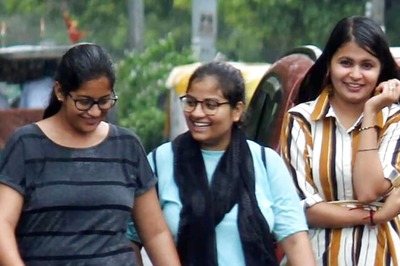
views
The most significant of the Sikh gurdwaras and the largest, Harmandir Sahib, sees footfalls of about 1,00,000 people every day. Of these, about 50,000-80,000 people take the langar meal each day and perhaps double that number on weekends and days of religious significance. The langar was instituted in 1577 by Guru Ramdas Ji, the fourth of the Holy Sikh Gurus. The Golden Temple langar complex, the Guru Ramdas Community Kitchen with its one-acre spread of workspaces, kitchens and two dining halls, is located just off the entrance to the eastern side of the temple courtyard, near the dukh bhanjani Ber tree. It is an awe-inspiring sight to see how the place operates and how such huge numbers are managed.
The kitchens are run with a military kind of efficiency and kept sparkling clean. Food is served through the day and night, except for a short break from about 4.30 to 5.00 am. The langar is cooked in three batches. The dining halls extending to over 50,000 sq. ft can cater to about 5,000 persons at a time. There are about 500 staff (including 12-15 cooks) working in three shifts, employed by the Shiromani Gurdwara Parbandhak Committee, which is in charge of the operations of the gurudwara. Some 150 sewadars and 250 volunteers assist in carrying out the myriad tasks of running what has been termed the world’s largest free kitchen. Volunteers help in all activities except for actual cooking, which is performed by the cooks.
Staff, sewadars and volunteers are grouped for each type of service. There are demarcated places for volunteers to prepare food, such as for peeling potatoes and chopping vegetables. Sewadars and helpers handle the washing up. All used utensils, plates and spoons need to be cleaned once a batch of devotees have eaten. Each plate is washed three to five times to ensure it is clean and fit for the next diner.
Making the Langar at the Golden Temple
On a typical day, the food service at the Golden Temple starts at 5 am. Pilgrims who have slept overnight at the temple complex assemble at the dining halls and sit down in rows for the morning tea and biscuits. Sewadars roll steel containers on wheels down the rows. Tea flows into small steel cups from a spigot at the bottom of each container. From 5 to 7.30 am, about 50,000 cups of tea are served along with biscuits or bread. Tea is usually available through the day, outside the dining halls.
By 8 am, the kitchens are ready with the first meal of the day. Diners keep their heads covered as they had done for entering the Darbar Sahib. Volunteers hand out clean stainless steel plates, katoris (bowls) and spoons. The sewadars go down the rows ladling out rice, dal and curries from stainless steel pails. Rotis are usually placed on the outstretched hands of the diner, similar to how the karah parshad is distributed, indicating humility on the part of the receiver of the blessing. Once a batch of diners leaves the hall, volunteers quickly clear the room of plates, bowls and spoons. Another set of volunteers mop the floor while yet another starts washing the used plates and cutlery in long troughs fitted with tubes of running water. The thousands of cleaned steel plates are stacked in huge trolleys. In no time, everything is ready for the next batch of diners.
The menu comprises rice, dal, chapati, sabzi, channa, a salad and a dessert, usually kheer such as lauki ki kheer, sheera or both (the variety of vegetable curry and kheer changes from day to day depending on the menu and the ingredients on hand). The dal is usually the utterly delicious langar wali dal. One room, fitted with huge cauldrons seated on ovens fuelled by wood fire, is set aside for making dal. In each cauldron, 400 kg of dal is slow cooked for about three hours with onions, garlic, 12 kg of masala, 12 kg haldi (turmeric powder), 24 kg salt and 48 kg ghee. Periodically, the dal is stirred using a long rod but is otherwise left to cook undisturbed.
Most of the work at the kitchens is manual. There are three chapatti-making machines with conveyor belts, each with a capacity to turn out 4,000 chapati per hour. However, as service is integral to the langar, these machines are used only when there are very large numbers to be fed. Women volunteers manually make chapati on normal days and supplement the machines on high traffic days. The women roll out the chapati with speed and dexterity, on an assembly line system. One set rolls the rotis, another group, usually men sewadars, tend to them on the huge hot plate, flipping them over with a long rod. A third applies a little ghee on each roti with the help of a bit of cloth tied to a stick and dipped in the bowl of ghee.
On festivals and special days such as Gurupurub and Diwali, additional items may be added to the menu. Jalebis are a highlight on Baisakhi.
The annual budget for the temple has been recorded as Rs 1,106 crore for 2017-18. About Rs 30 crore is set aside for the langar (Rs 12 lakh per day for normal days and Rs 16 lakh per day on festival days), with about 25 per cent of the materials required being offerings by devotees. A procurement team and manager plan, purchase and arrange the logistics for the rest of the materials. A small fleet of vehicles pick up the material from the entrance to the city, as the roads leading to the langar complex are too narrow to permit large trucks and lorries. Firewood and gas fuel the kitchen, supported by the electricity-run chapati makers. About 5,000 kg of firewood and 100 LPG gas cylinders are used every day. The ghee used is pure desi ghee and it gives the food a special aroma and taste. Atta to the tune of 10,000-12,000 kg; 10,000-13,000 kg of dal; 1,000-1,500 kg rice; 2,000 kg of vegetables; 500-700 kg ghee; 1,000 kg sugar and 5,000 litres of milk are consumed every day. At least 750 kg of dry milk powder is used for kheer per day.
Read all the Latest News, Breaking News and Coronavirus News here. Follow us on Facebook, Twitter and Telegram.



















Comments
0 comment